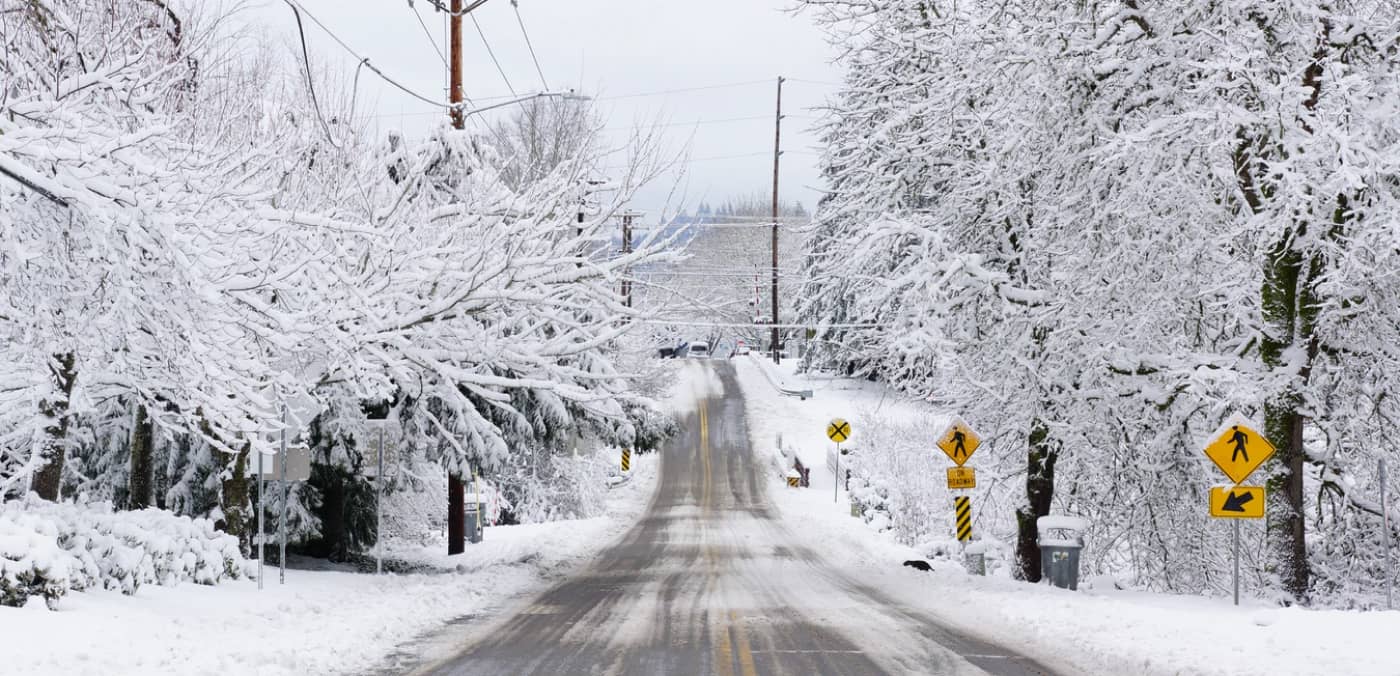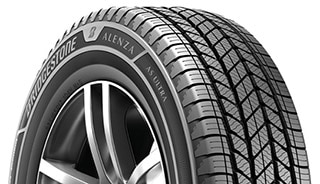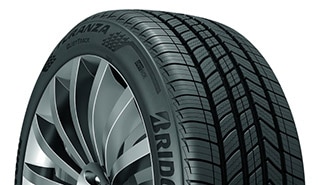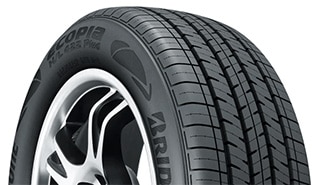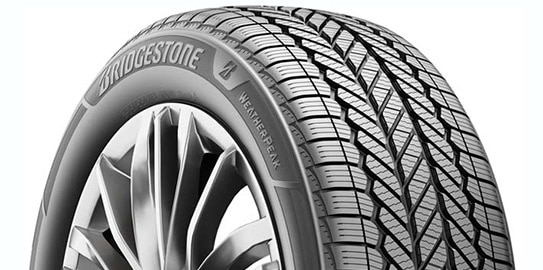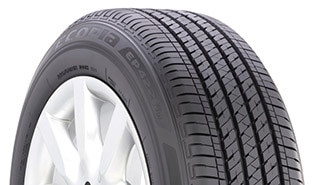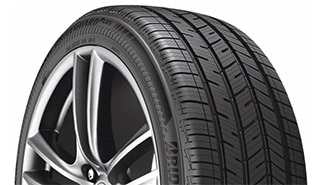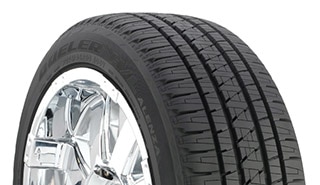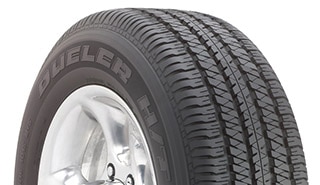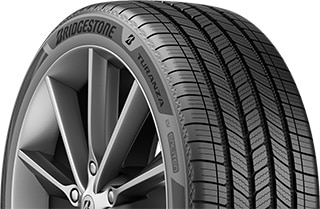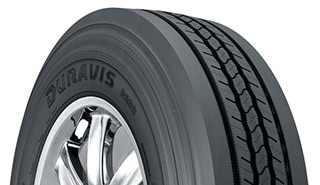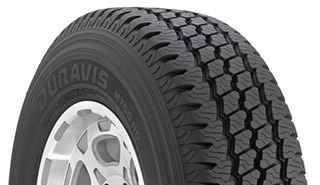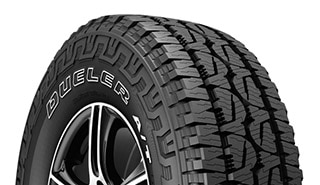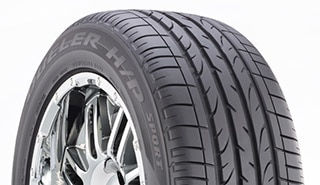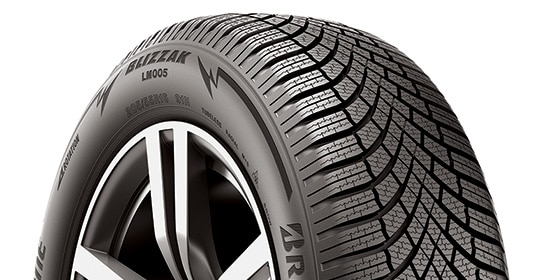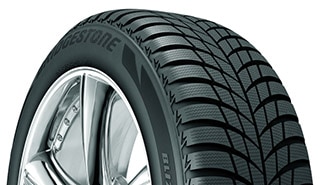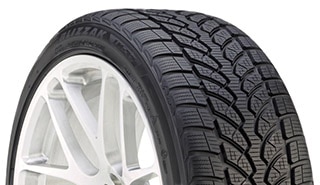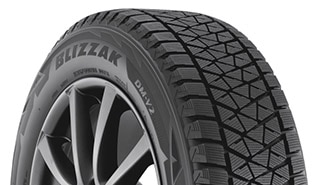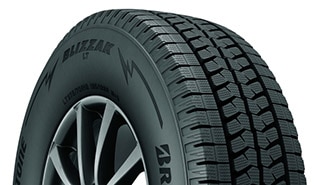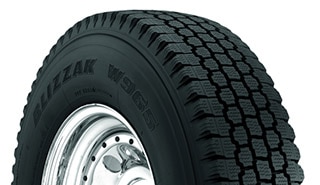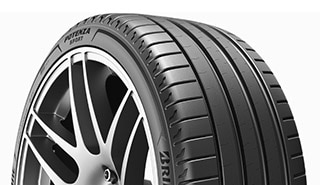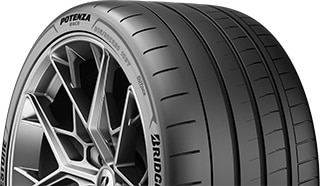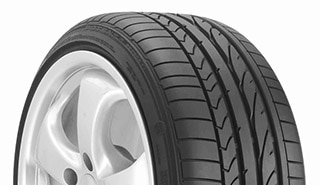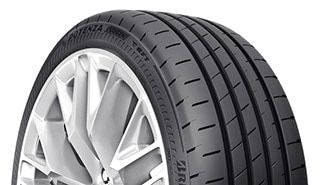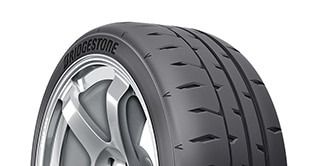HOW TO DRIVE IN SNOW: START WITH THE RIGHT TIRES
If you regularly drive in wintry conditions, your safety depends on how well your tires grip the road. Your all-season tires may be driven on year-round, but they're likely not the best choice for snow and ice.
Create a safer driving experience with the right winter tires for your vehicle. Not sure how to choose winter tires? Read up on the types of winter tires:
- 3 Peak Mountain Snowflake-rated all-season tires: A few all-season tires are rated for severe snow service (as indicated by the 3 Peak Mountain Snowflake symbol on their sidewall). Sometimes referred to as “All Weather” tires, they can be a great option in areas that receive moderate snowfall and don’t experience extremely icy conditions, but they're not going to be the best fit for areas that experience regular winter storms and sub-zero temperatures.
- Studless winter tires: With their time-tested design, winter tires like Blizzak studless tires give you more grip and better control when snow, ice, and slush are on the road - even when temps drop below zero..
- Studded winter tires: Studs on winter tires offer enhanced traction on ice, but they increase tire noise dramatically. Note that some local laws prohibit studded tires as they can contribute to road surface deterioration. You can check your state's studded tire laws on AAA.com.
Whether you're just now learning how to drive in snow and ice or you're a well-seasoned winter driver, choosing the right winter tires can make all the difference in maintaining vehicle control — and staying safe — on the road. Not sure how to select the best tires for your vehicle, region, and driving habits? Your nearby authorized Bridgestone tire center is ready to help with expert advice.
PREPARING TO DRIVE IN SNOW AND ICE
Even with the best winter tires, driving in severe winter weather is inherently dangerous. Before you hit the road, consider whether your trip is essential. Here are a few preparatory winter driving tips that can help you be safe if you must drive.
1. WINTERIZE YOUR CAR WELL IN ADVANCE OF SEVERE WEATHER.
If you choose to have winter tires installed, don't stop there with your winter car prep. Check out our steps for how to winterize your car so you'll be prepared for anything the road brings your way.
2. CHECK THE FORECAST.
As temperatures fluctuate around 32℉, snow and ice are likely to melt on the roadway or refreeze as black ice, leading to slicker conditions than packed snow. Check your local weather forecast before you get behind the wheel and adjust your driving behaviors accordingly in the event of significant temperature changes.
3. TEST THE ROAD CONDITIONS.
If possible, find an empty stretch of road close to your home where you can test out acceleration, braking, and steering before you set out on a long drive in winter weather. You may find that you'd rather not drive after all. It's far better to discover that conditions are questionable when you're close to home instead of driving miles away only to find out that road conditions aren't as favorable as you'd hoped.
WINTER DRIVING TIPS | EVALUATE CHANGING TEMPERATURES
Changing temperatures can affect your tires' ability to grip the road's surface. Listen to the pros and know what to expect when the thermometer shifts.
ACCELERATING AND BRAKING IN SNOW AND ICE
When it's time to hit the road in wintry weather conditions, there's one goal: maintain control of the vehicle. Jerking movements or sudden speed changes can cause a loss of traction, so follow these tips for how to drive in snow without losing grip on the road.
- Accelerate smoothly. Apply gentle pressure to the gas pedal, even if that means you take more time to reach your safe cruising speed. Placing too much pressure on the gas pedal may cause the drive wheels to lose traction and spin, so keep things slow and gradual when accelerating.
- Brake gradually. Similar to the gentle pressure you should use on the accelerator, use your brake pedal for gradual slowing rather than sudden stops. Slamming on the brakes is a recipe for skids in winter weather.
- Leave more space for braking. Keep a watchful eye on the road and landscape ahead so you'll have plenty of time and space to anticipate obstacles and come to a gradual stop. If you're behind another car, be sure to allow a following distance of 6-10 seconds (rather than the typical 3-4 seconds) to ensure you'll be able to stop without rear-ending someone.
- Keep your foot on the brake if your anti-lock braking system (ABS) activates. If your car has anti-lock brakes, you may feel pulsating when you depress the pedal. If this happens, do not let up on the brakes—keep your foot firmly planted and trust that your ABS is doing its job to keep your brakes functioning.
REDUCE YOUR SPEED WHEN DRIVING IN SNOW AND ICE
It's easier to stop when you're driving at low speeds, and for this reason, you should always reduce your speed significantly when driving on snow-covered roads. Snow can make braking and accelerating feel entirely different to you, the driver, and keeping your pace in check is the best way to ensure you'll have enough time to stop safely. Additionally, higher speeds can lead to diminished tire traction, increasing your risk of skids (check out the next section on how to steer in snow for more info on skidding).
One way to keep your speed under control is to use a lower gear on your vehicle's transmission. Rather than using the brakes to slow down from a too-high speed, keep your car in low gear to prevent the engine from reaching higher speeds in the first place. Here are a few things to keep in mind for low-gear driving in winter weather.
- For manual transmission: Be mindful and gentle when engaging the clutch. If you engage it immediately after significant acceleration, your wheels may spin out of control. Instead, keep things smooth and steady. In general, try to anticipate hills or speed changes by shifting into a lower or higher gear, rather than overusing your accelerator or brake pedal.
- For automatic transmission: For the most part, you can let your transmission do the work for you. Modern automatic transmissions are adept at working with traction control systems and adjusting to low traction levels. Many automatic transmissions also have a manual mode or the ability to manually select low gears (usually 1-3), offering you more control over your speed when driving in snow.
No matter what type of transmission your vehicle has, loss of traction is most likely to occur when you're accelerating, braking, or turning. Again, be sure to keep your speed changes gradual and smooth, and read on to learn how to correct loss of traction when turning.
HOW TO STEER IN SNOW AND ICE
Just as acceleration and braking should be gentle and gradual, steering should be slow and smooth. Jerky movements are a recipe for skids. When it comes to learning how to drive in snow and ice, it's vital that you can identify and correct two common steering problems: oversteer and understeer.
WHAT IS OVERSTEER?
Oversteer is a rear-wheel skid. When you're turning too fast on snow or ice, your vehicle's weight shifts onto the front tires, and the rear tires lose grip. The car's rear will swing toward the outside of the turn rather than the direction you're steering.
HOW TO CORRECT OVERSTEER
- Do: Steer in the direction of the skid, and gently accelerate until you regain control.
- Don't: Slam on the brakes or overcompensate with large or jerking steering motions.
WHAT IS UNDERSTEER?
Understeer is a front-wheel skid. When your front tires lose grip, your steering motions won't affect the direction of your car—it will just keep moving in its current direction.
HOW TO CORRECT UNDERSTEERING
- Do: Take your foot off the accelerator and slowly turn the wheel back toward straight until your front tires regain grip.
- Don't: Steer harder into a turn or slam on the brakes.
TAKE ADVANTAGE OF YOUR VEHICLE'S DRIVETRAIN
Whether your vehicle has front-wheel drive or rear-wheel drive, the type of drivetrain makes a difference in how you should approach winter driving. Learn how to drive in snow and ice most effectively by diving deeper into your drivetrain.
HOW TO DRIVE IN SNOW WITH FRONT WHEEL DRIVE
Vehicles with front-wheel drive typically have better traction in snow and ice than rear-wheel drive vehicles. In front-wheel drive vehicles, the front of the car carries more weight than the back, making it easier to maintain traction and keep your vehicle moving in the desired direction. Still, reduce your speed in winter weather, and be careful not to make too many steering motions as you drive.
HOW TO DRIVE RWD IN SNOW
While it's true that rear-wheel drive vehicles may make it harder to maintain traction due to their rear-heavy weight distribution, it's not impossible to safely drive in snow with RWD. Take things slow, particularly when you're turning your vehicle, to prevent fishtailing and a loss of control.
Additionally, you can load up your rear cargo area with heavy bags of sand or cat litter to keep more weight bearing down your rear tires and thus increase their traction. Ultimately, though, winter tires are one of the best ways to increase traction when driving a RWD car in snow or ice.
GEAR UP FOR WINTER
Ready to equip your car, truck, SUV, or minivan with best-in-class winter tires? Talk to a tire pro today. Bridgestone winter and snow tires are right around the corner. Gear up so you can get out and drive safe! Shop Bridgestone tires near you.



